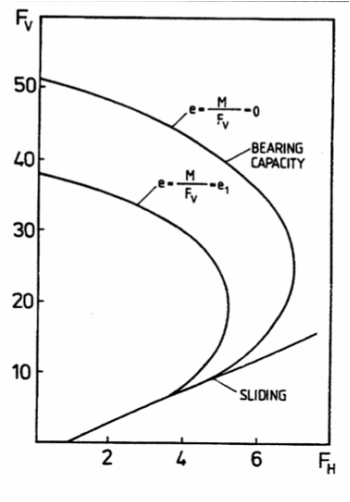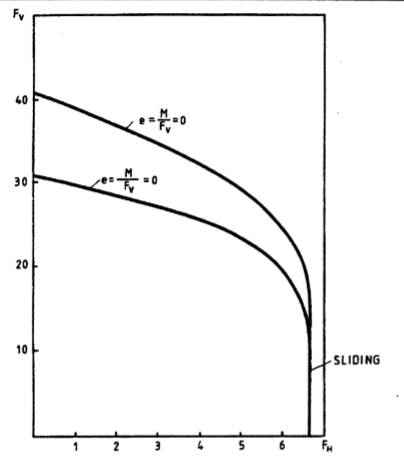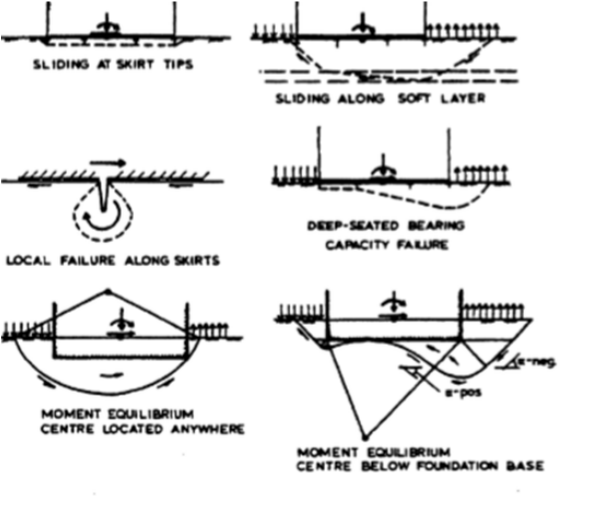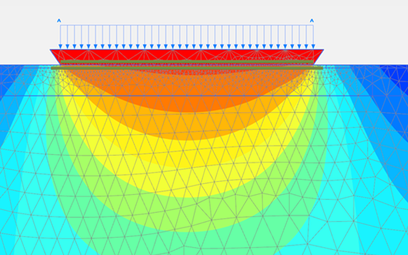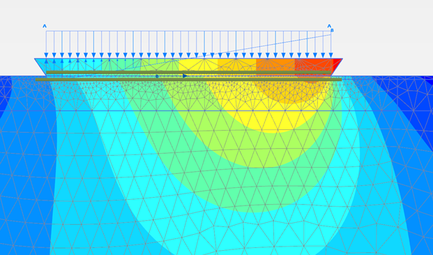Shallow Foundation Design
Introduction
Shallow foundations in the context of this website are defined as a skirted or un-skirted mud mat, if a skirt is adopted then it should be fully penetrated under the self weight of the structure. The foundations could comprise single or multiple footings.
Shallow foundations in the context of this website are defined as a skirted or un-skirted mud mat, if a skirt is adopted then it should be fully penetrated under the self weight of the structure. The foundations could comprise single or multiple footings.
Design Codes - Spreadsheet Checks
Any design code will aim to check the suitability of the design under design loading depending upon their likelihood to occur which as a minimum may include:
There are many uncertainties and limitations with the simplified methods for calculation of shallow foundation bearing / sliding capacity:
Any design code will aim to check the suitability of the design under design loading depending upon their likelihood to occur which as a minimum may include:
- Ultimate Limit State (ULS)
- Accidental Limit State (ALS)
- Serviceability Limit State (SLS)
- Seismic (ELE / ALE)
There are many uncertainties and limitations with the simplified methods for calculation of shallow foundation bearing / sliding capacity:
- Multiple soil layers (methods available for uniform sand, uniform strength clay and clay linearly increasing strength)
- Non-standard foundation geometry (methods available for rectangles and circles)
- Multiple footing foundations (limited codified guidance on load distribution and footing interaction)
- Conservatism inherent in the 'effective area' concept adopted for the moment loading component
- Foundation interaction with rock or nearby seabed depressions (jack-up rig spuds for example)
Advanced Analyses
Optimisation of the capacity or settlement assessment of shallow foundations does not necessarily mean using advanced software (but it helps). The following publications over the past few years from Cathie Associates, BP and UWA may be of use depending on the soil conditions / loads governing your design:
The final paper presents a summary of recent R&D at UWA which can lead to significant mudmat/skirted mudmat size reduction or indeed the use of foundations which are designed to slide across the seabed. See the blog for a review of this paper.
Limit State Analyses and / or 2D / 3D FEA are increasingly used tools to better understand foundation response under a range of loading. Of critical importance is selection of the correct soil model and input parameters to correctly represent the analyses being performed.
The VHM interaction envelopes (such as those generated above using simplified approaches in DNV) may be created in such software for a given foundation configuration and soil type. If used correctly, this software should allow optimisation of geotechnical foundation design.
Some validation of 3D FEA in very soft clay and recommendations for simplifying the analyses into a spreadsheet assessment (presumably for use a quick foundation capacity screening assessment) has recently been published (see blog 'favourite shallow foundation design papers').
Optimisation of the capacity or settlement assessment of shallow foundations does not necessarily mean using advanced software (but it helps). The following publications over the past few years from Cathie Associates, BP and UWA may be of use depending on the soil conditions / loads governing your design:
- A framework for the design of sliding mudmat foundations (ISFOG 2012)
- Hybrid Subsea Foundations for Subsea Equipment (ASCE)
- Whole life assessment of subsea shallow foundation capacity (OSIG 2017)
The final paper presents a summary of recent R&D at UWA which can lead to significant mudmat/skirted mudmat size reduction or indeed the use of foundations which are designed to slide across the seabed. See the blog for a review of this paper.
Limit State Analyses and / or 2D / 3D FEA are increasingly used tools to better understand foundation response under a range of loading. Of critical importance is selection of the correct soil model and input parameters to correctly represent the analyses being performed.
The VHM interaction envelopes (such as those generated above using simplified approaches in DNV) may be created in such software for a given foundation configuration and soil type. If used correctly, this software should allow optimisation of geotechnical foundation design.
Some validation of 3D FEA in very soft clay and recommendations for simplifying the analyses into a spreadsheet assessment (presumably for use a quick foundation capacity screening assessment) has recently been published (see blog 'favourite shallow foundation design papers').
